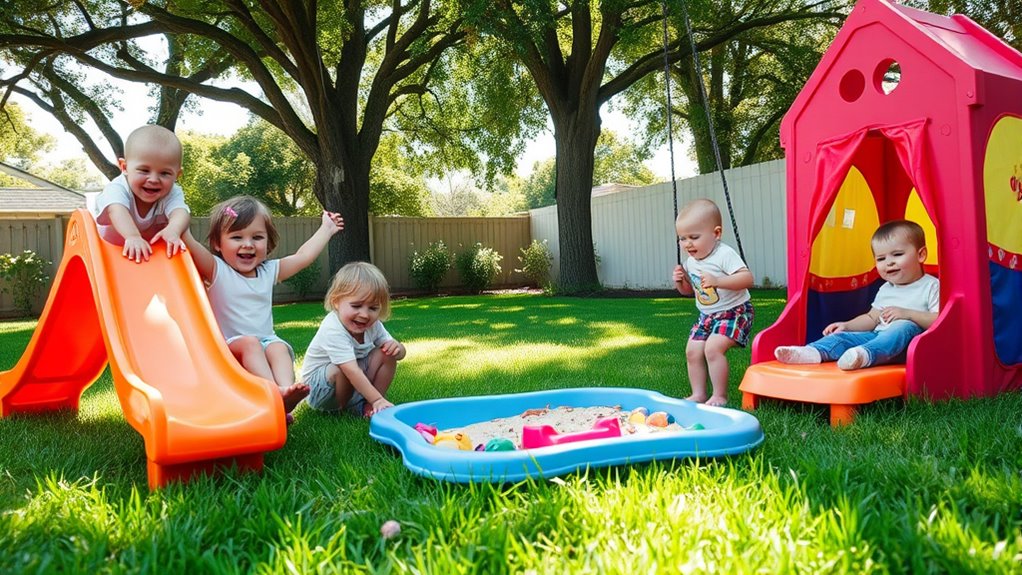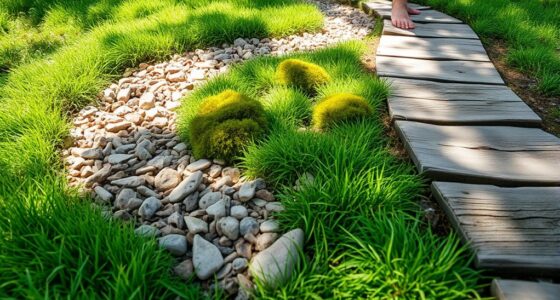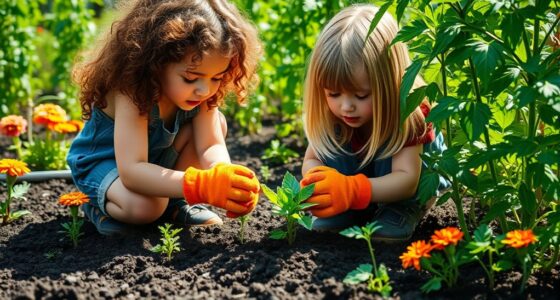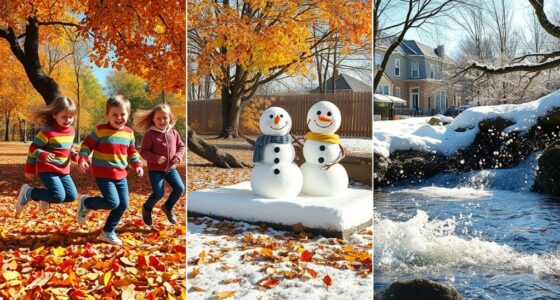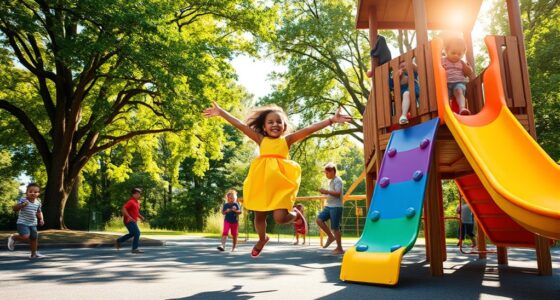Create a fun-filled backyard adventure by setting up sensory stations with natural materials like leaves, rocks, and sticks for your toddler to explore. Organize a simple scavenger hunt or a mini nature trail to spark curiosity, and include safe water or sand play to enhance sensory experience. Add planting areas or small gardening activities to teach responsibility. Keep safety a priority and watch your child’s confidence grow. Explore more ideas to inspire endless outdoor fun.
Key Takeaways
- Create a nature trail or scavenger hunt to promote exploration and curiosity in toddlers.
- Incorporate sensory stations with textured materials, water, and natural objects for tactile engagement.
- Establish a small garden bed for planting, nurturing responsibility, and observing plant growth.
- Add safe, interactive features like a sandbox or shallow pond to stimulate senses and fine motor skills.
- Ensure a secure environment by supervising activities and designing natural boundaries for safe outdoor play.
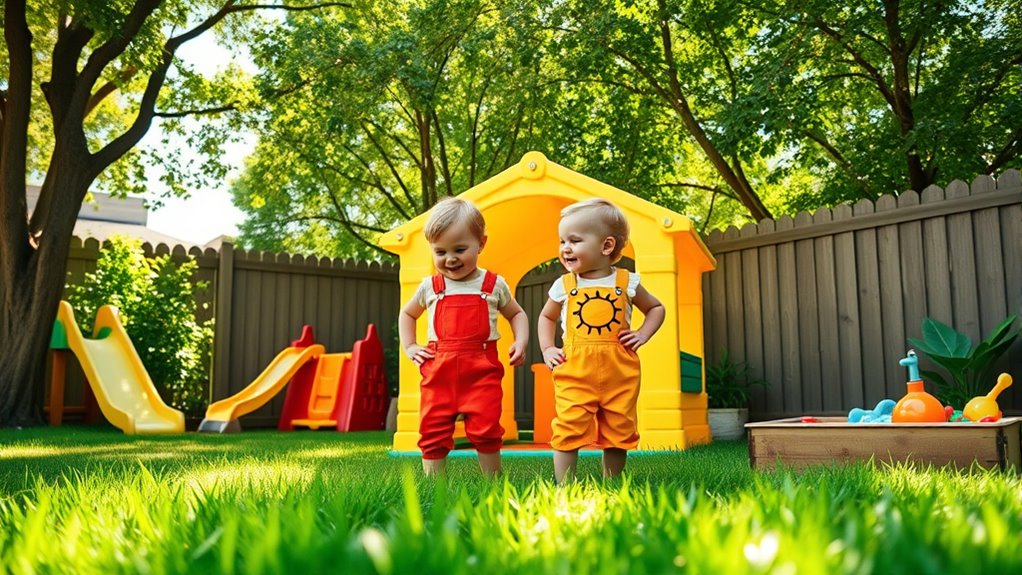
Have you ever wondered how to turn your backyard into a fun-filled retreat? Creating an engaging outdoor space for your toddler doesn’t have to be complicated. In fact, it’s all about encouraging curiosity and discovery through simple activities like nature exploration and sensory play. These experiences help your little one connect with the environment while developing important skills. With a few thoughtful setups, your backyard can transform into an exciting adventure zone that sparks your child’s imagination and love for the outdoors.
Start by designing a dedicated area for nature exploration. You can gather natural materials such as leaves, rocks, sticks, and flowers and create a mini nature trail or scavenger hunt. Encourage your toddler to observe and collect different textures, colors, and shapes. This hands-on interaction fosters curiosity and helps them learn about the world around them. Incorporate features like a small garden bed where they can plant and watch seedlings grow. This not only teaches responsibility but also offers ongoing opportunities for exploration as plants sprout and bloom. Adding a sandbox or a shallow pond with floating toys can further stimulate their senses and invite them to experiment with different natural elements.
Sensory play is another key component of backyard adventures. Set up areas with various textures—such as a patch of grass, smooth stones, rough bark, and soft moss—to stimulate your child’s tactile senses. Incorporate containers filled with water, rice, or beans where your toddler can scoop, pour, and feel different sensations. Use natural objects like pinecones, feathers, or shells to enhance their sensory experience. These activities keep their hands busy and help refine fine motor skills while making the outdoors more engaging. You can also introduce scent jars with herbs or flowers, allowing your child to explore different smells, which sharpens their olfactory senses and promotes language development as they describe what they smell. Engaging in outdoor play also provides opportunities for children to develop their gross motor skills and coordination naturally.
Safety is essential, so ensure your backyard is a secure environment. Keep hazards out of reach and supervise your toddler during all activities. Use natural elements to create boundaries or zones for exploration, giving your child freedom to roam while maintaining safety. Remember, the goal isn’t just fun but also fostering a sense of wonder and learning through direct interaction with nature. By blending nature exploration and sensory play, you give your toddler the tools to develop their curiosity, motor skills, and emotional confidence. With a little planning, your backyard can become a magical place where every day brings a new adventure, helping your child grow and learn in a natural, joyful setting.
Frequently Asked Questions
What Safety Gear Is Recommended for Toddler Outdoor Play?
When you’re planning outdoor play for your toddler, safety gear is essential. You should provide protective clothing like hats and long sleeves to shield against scrapes and sun exposure. Don’t forget sun protection—apply broad-spectrum sunscreen and use sunglasses to protect their eyes. Always supervise closely, and consider soft landing surfaces around play areas. These steps help keep your little one safe while they enjoy outdoor adventures.
How Can I Keep Toddlers Engaged Outdoors for Longer Periods?
Think outside the box to keep toddlers engaged outdoors longer. You can introduce interactive water play and nature scavenger hunts, which keep their curiosity piqued. Setting up simple, fun activities that change throughout the day prevents boredom and encourages exploration. By mixing up the activities and involving their senses, you’ll make outdoor time exciting, turning short visits into longer, memorable adventures for your little ones.
What Are Some Quiet Outdoor Activities for Toddlers?
You can keep toddlers engaged outdoors with quiet activities like nature crafts, where they create art using leaves, flowers, and sticks. Cloud watching is another calming option; guide them to lie back and observe the sky, pointing out shapes and patterns. These activities promote relaxation and curiosity, helping toddlers enjoy peaceful outdoor moments while developing their creativity and observation skills. They’re perfect for gentle, engaging outdoor fun.
How to Introduce Gardening to Young Children Safely?
Introducing gardening to young children is like opening a storybook filled with wonder. Start by choosing safe, child-friendly garden tools and simple, colorful plants. Show them how to gently dig, water, and care for their plants, emphasizing safety and patience. Let their curiosity blossom as they learn about plant selection and growth. With hands-on guidance, you’ll nurture their love for nature and teach them important life skills.
What Should I Do if My Toddler Gets Scared Outside?
If your toddler gets scared outside, focus on fear management by reassuring them with calm, comforting words. Use comfort strategies like holding their hand or bringing along a favorite toy to help them feel safe. Gradually introduce outdoor environments, allowing your child to explore at their own pace. Stay patient and supportive, and praise their courage to build confidence and help them feel secure during outdoor adventures.
Conclusion
Now, as you watch your little one giggle and explore, remember that these backyard adventures aren’t just fun—they’re the building blocks of their confidence and curiosity. Each tiny step they take in your yard is a leap toward discovery and joy. So, create those precious moments, because in their bright eyes and sparkling smiles, you’ll find the true magic of childhood—an endless garden of wonder waiting to be uncovered.

